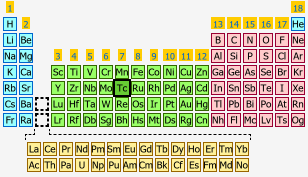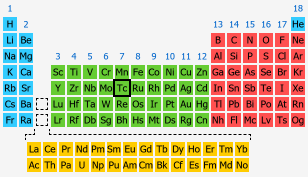References (Click the  next to a value above to see complete citation information for that entry)
next to a value above to see complete citation information for that entry)
Andersen, T., H. K. Haugen, and H. Hotop. "Binding Energies in Atomic Negative Ions: III." Journal of Physical and
Chemical Reference Data, volume 28, number 6, 1999, pp. 1511–1533.
Journal of Physical and
Chemical Reference Data, volume 28, number 6, 1999, pp. 1511–1533.
Batsanov, S. S. "Van der Waals Radii of Elements." Inorganic Materials, volume 37, number 9, 2001, pp. 871–885. See abstract
Campbell, J. L. "Fluorescence Yields and Coster–Kronig Probabilities for the Atomic L Subshells." Atomic Data and Nuclear Data Tables, volume 85, number 2, 2003, pp. 291–315. doi:10.1016/S0092-640X(03)00059-7
Cardarelli, François. Materials Handbook: A Concise Desktop Reference, 2nd edition. London: Springer–Verlag, 2008.
Clementi, E., D. L. Raimondi, and W. P. Reinhardt. "Atomic Screening Constants from SCF Functions. II. Atoms with 37 to 86 Electrons." Journal of Chemical Physics, volume 47, number 4, 1967,
pp. 1300–1307. doi:10.1063/1.1712084
Cohen, E. Richard, David R. Lide, and George L. Trigg, editors. AlP Physics Desk Reference, 3rd edition. New York: Springer-Verlag New York, Inc., 2003.
Connelly, Neil G., Ture Damhus, Richard M. Hartshorn, and Alan T. Hutton. Nomenclature of Inorganic Chemistry: IUPAC Recommendations 2005. Cambridge: RSC Publishing, 2005.
Cambridge: RSC Publishing, 2005.
Cordero, Beatriz, Verónica Gómez, Ana E. Platero-Prats, Marc Revés, Jorge
Echeverría, Eduard Cremades, Flavia Barragán, and Santiago Alvarez. "Covalent Radii Revisited." Dalton Transactions, number 21, 2008, pp 2832–2838. doi:10.1039/b801115j
Cox, P. A. The Elements: Their Origin, Abundance and
Distribution. Oxford: Oxford University Press, 1989.
de Podesta, Michael. Understanding the Properties of Matter, 2nd edition. London: Taylor & Francis, 2002.
Dronskowski, Richard. Computational Chemistry of Solid State Materials. Weinheim, Germany: WILEY-VCH Verlag GmbH & Co. KGaA, 2005.
Emsley, John. Nature's Building Blocks: An A-Z Guide to the Elements. Oxford: Oxford University Press, 2003.
Emsley, John. The Elements, 3rd edition. Oxford: Oxford University Press, 1998.
Firestone, Richard B. Table of Isotopes, 8th edition, volume 2. Edited by Virginia S. Shirley, with assistant editors Coral M. Baglin, S. Y. Frank Chu, and Jean Zipkin. New York: John Wiley & Sons, Inc., 1996.
Ghosh, Dulal C., and Kartick Gupta. "A New Scale Of Electronegativity Of 54 Elements Of Periodic Table Based On Polarizability Of Atoms." Journal of Theoretical and Computational Chemistry, volume 5, number 4, 2006, pp. 895–911. doi:10.1142/S0219633606002726
Greenwood, N. N., and A. Earnshaw. Chemistry of the
Elements, 2nd edition. Oxford: Butterworth-Heinemann, 1997.
Gwyn Williams. Electron Binding Energies. http://www.jlab.org/~gwyn/ebindene.html . Accessed on April 30, 2010.
. Accessed on April 30, 2010.
Ho, C. Y., R. W. Powell, and P. E. Liley. "Thermal Conductivity of the Elements: A Comprehensive Review." Journal of Physical and Chemical Reference Data, volume 3, supplement 1, 1974, pp. I–1 to I–796.
Journal of Physical and Chemical Reference Data, volume 3, supplement 1, 1974, pp. I–1 to I–796.
Horvath, A. L. "Critical Temperature of Elements and the Periodic System." Journal of Chemical Education, volume 50, number 5, 1973, pp. 335–336. doi:10.1021/ed050p335
Huheey, James E., Ellen A. Keiter, and Richard L Keiter. Inorganic Chemistry: Principles of Structure and Reactivity, 4th edition. New York: HarperCollins College Publishers, 1993.
Jr., Elbert J. Little,, and Mark M. Jones. "A Complete Table of Electronegativities." Journal of Chemical Education, volume 37, number 5, 1960, pp. 231–233. doi:10.1021/ed037p231
Kittel, Charles. Introduction to Solid State Physics, 8th edition. Hoboken, NJ: John Wiley & Sons, Inc, 2005.
Krause, M. O. "Atomic Radiative and
Radiationless Yields for K and L Shells." Journal of Physical and Chemical Reference Data, volume 8, number 2, 1979, pp. 307–327.
Journal of Physical and Chemical Reference Data, volume 8, number 2, 1979, pp. 307–327.
Kurakado, Masahiko, Toshiro Takabatake, and Hiromasa Mazaki. "Superconducting Transition Temperature of Technetium and Lead." Bulletin of the Institute for Chemical Research, Kyoto University, volume 55, number 1, 1977, pp. 38–45.
Bulletin of the Institute for Chemical Research, Kyoto University, volume 55, number 1, 1977, pp. 38–45.
Liboff, Richard L. Introductory Quantum Mechanics, 3rd edition. Reading, MA: Addison Wesley Longman, Inc.,
1998.
Lide, David R., editor. CRC Handbook of Chemistry and Physics, 88th edition. Boca Raton, Florida: Taylor & Francis Group, 2008.
Mann, Joseph B., Terry L. Meek, Eugene T. Knight, Joseph F. Capitani, and Leland C. Allen. "Configuration Energies of the d-Block Elements." Journal of the American Chemical Society, volume 122, number 21, 2000, pp. 5132–5137. doi:10.1021/ja9928677
Marshall, James L. Discovery of the Elements: A Search for the Fundamental Principles of the Universe, 2nd edition. Boston, MA: Pearson Custom Publishing, 2002.
Martin, W. C. "Electronic Structure of the Elements." The European Physical Journal C — Particles and Fields,
volume 15, number 1–4, 2000, pp. 78–79. doi:10.1007/BF02683401
Miessler, Gary L., and Donald A. Tarr. Inorganic Chemistry, 3rd edition. Upper Saddle River, NJ: Pearson Prentice Hall,
2004.
Moore, Charlotte E. Ionization Potentials and Ionization Limits Derived from the Analyses of Optical Spectra. Washington, D.C.: National Bureau of Standards, 1970.
Nagle, Jeffrey K. "Atomic Polarizability and Electronegativity." Journal of the American Chemical Society, volume 112, number 12, 1990, pp. 4741–4747. doi:10.1021/ja00168a019
Oxtoby, David W., H. P. Gillis, and Alan Campion. Principles of Modern Chemistry, 6th edition. Belmont, CA: Thomson Brooks/Cole, 2008.
Pauling, Linus. The Nature of the Chemical Bond, 3rd edition. Ithaca, NY: Cornell University Press, 1960.
Pekka Pyykkö. Self-Consistent, Year-2009 Covalent Radii. http://www.chem.helsinki.fi/~pyykko/Radii09.pdf . Accessed on November 20, 2010.
. Accessed on November 20, 2010.
Perrier, C., and E. Segrè. "Some Chemical Properties of Element 43." Journal of Chemical Physics, volume 5, number 9, 1937, pp. 712–716. doi:10.1063/1.1750105
Pyykkö, Pekka, and Michiko Atsumi. "Molecular Double-Bond Covalent Radii for Elements Li-E112." Chemistry - A European Journal,
volume 15, number 46, 2009, pp. 12770–12779. doi:10.1002/chem.200901472
Pyykkö, Pekka, and Michiko Atsumi. "Molecular Single-Bond Covalent Radii for Elements 1-118." Chemistry - A European Journal,
volume 15, number 1, 2009, pp. 186–197. doi:10.1002/chem.200800987
Pyykkö, Pekka, Sebastian Riedel, and Michael Patzschke. "Triple-Bond Covalent Radii." Chemistry - A European Journal,
volume 11, number 12, 2005, pp. 3511–3520. doi:10.1002/chem.200401299
Sansonetti, J. E., and W. C. Martin. "Handbook of Basic Atomic Spectroscopic Data." Journal Of Physical And Chemical Reference Data, volume 34, number 4, 2005, pp. 1559–2259. doi:10.1063/1.1800011
Journal Of Physical And Chemical Reference Data, volume 34, number 4, 2005, pp. 1559–2259. doi:10.1063/1.1800011
Schwochau, Klaus. Technetium Chemistry and Radiopharmaceutical Applications. Weinheim, Germany: WILEY-VCH Verlag GmbH, 2000.
Sekula, S. T., R. H. Kernohan, and G. R. Love. "Superconducting Properties of Technetium." Physical Review, volume 155, number 2, 1967, pp. 364–369. doi:10.1103/PhysRev.155.364
Shannon, R. D. "Revised Effective Ionic Radii and Systematic Studies of Interatomic Distances in Halides and Chalcogenides." Acta Crystallographica Section A, volume 32, number 5, 1976, pp. 751–767. doi:10.1107/S0567739476001551
Silbey, Robert J., Robert A. Alberty, and Moungi G. Bawendi. Physical Chemistry, 4th edition. Hoboken, NJ: John Wiley & Sons, Inc., 2005.
Singman, Charles N. "Atomic Volume and Allotropy of the Elements." Journal of Chemical Education, volume 61, number 2, 1984, pp. 137–142. doi:10.1021/ed061p137
Slater, J. C. "Atomic Radii in Crystals." The Journal of
Chemical Physics, volume 41, number 10, 1964, pp. 3199–3204. doi:10.1063/1.1725697
Smith, Derek W. Inorganic Substances: A Prelude to the Study of Descriptive Inorganic Chemistry. Cambridge: Cambridge University
Press, 1990.
Soukhanov, Anne H., editor. The American Heritage Dictionary Of The English Language, 3rd edition. Boston: Houghton Mifflin Company, 1992.
Stewart, G. R. "Measurement of low-temperature specific heat." Review of Scientific Instruments, volume 54, number 1, 1983, pp. 1–11. doi:10.1063/1.1137207
Stewart, G. R. "Measurement of Low-Temperature Specific Heat." Review of Scientific Instruments, volume 54, number 1, 1983, pp. 1–11. doi:10.1063/1.1137207
Tari, A. The Specific Heat of Matter at Low Temperatures. London: Imperial College Press, 2003.
Vainshtein, Boris K., Vladimir M. Fridkin, and Vladimir L. Indenbom. Structure of Crystals, 2nd edition. Modern Crystallography 2. Edited by Boris K. Vainshtein, A. A. Chernov, and L. A. Shuvalov. Berlin: Springer-Verlag, 1995.
Waber, J. T., and Don T. Cromer. "Orbital Radii of Atoms and Ions." Journal of Chemical Physics, volume 42, number 12, 1965, pp. 4116–4123. doi:10.1063/1.1695904
Waldron, Kimberley A., Erin M. Fehringer, Amy E. Streeb, Jennifer E. Trosky, and Joshua J. Pearson. "Screening Percentages Based on Slater Effective
Nuclear Charge as a Versatile Tool for Teaching Periodic Trends." Journal of Chemical Education, volume 78, number 5, 2001, pp. 635–639. doi:10.1021/ed078p635
Weeks, Mary Elvira, and Henry M. Leicester. Discovery of
the Elements, 7th edition. Easton, PA: Journal of Chemical Education, 1968.
Yaws, Carl L. "Liquid Density of the Elements." Chemical Engineering, volume 114, number 12, 2007, pp. 44–46.
Yaws, Carl L. The Yaws Handbook of Physical Properties for Hydrocarbons and Chemicals. Houston, TX: Gulf Publishing Company, 2005.



















































 next to a value above to see complete citation information for that entry)
next to a value above to see complete citation information for that entry) Journal of Physical and
Chemical Reference Data, volume 28, number 6, 1999, pp. 1511–1533.
Journal of Physical and
Chemical Reference Data, volume 28, number 6, 1999, pp. 1511–1533.


 Cambridge: RSC Publishing, 2005.
Cambridge: RSC Publishing, 2005.

 . Accessed on April 30, 2010.
. Accessed on April 30, 2010. Journal of Physical and Chemical Reference Data, volume 3, supplement 1, 1974, pp. I–1 to I–796.
Journal of Physical and Chemical Reference Data, volume 3, supplement 1, 1974, pp. I–1 to I–796.

 Journal of Physical and Chemical Reference Data, volume 8, number 2, 1979, pp. 307–327.
Journal of Physical and Chemical Reference Data, volume 8, number 2, 1979, pp. 307–327. Bulletin of the Institute for Chemical Research, Kyoto University, volume 55, number 1, 1977, pp. 38–45.
Bulletin of the Institute for Chemical Research, Kyoto University, volume 55, number 1, 1977, pp. 38–45.


 . Accessed on November 20, 2010.
. Accessed on November 20, 2010.



 Journal Of Physical And Chemical Reference Data, volume 34, number 4, 2005, pp. 1559–2259. doi:10.1063/
Journal Of Physical And Chemical Reference Data, volume 34, number 4, 2005, pp. 1559–2259. doi:10.1063/










